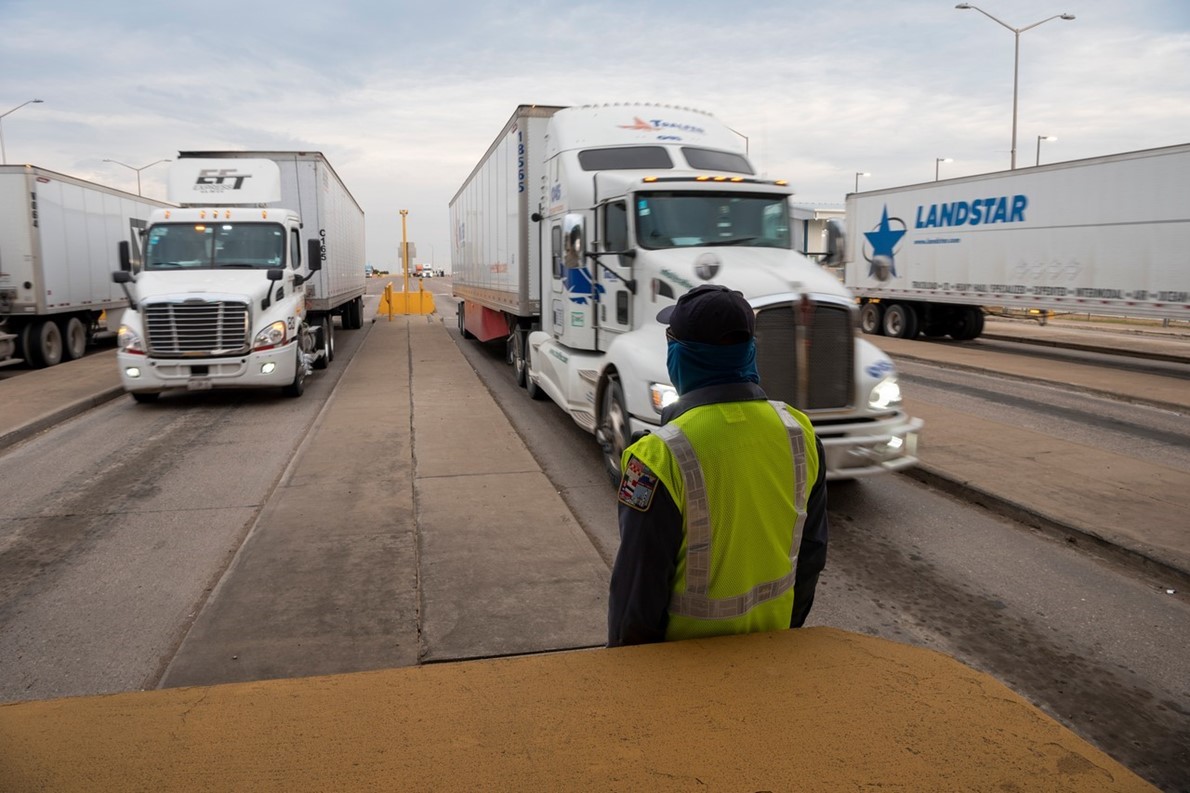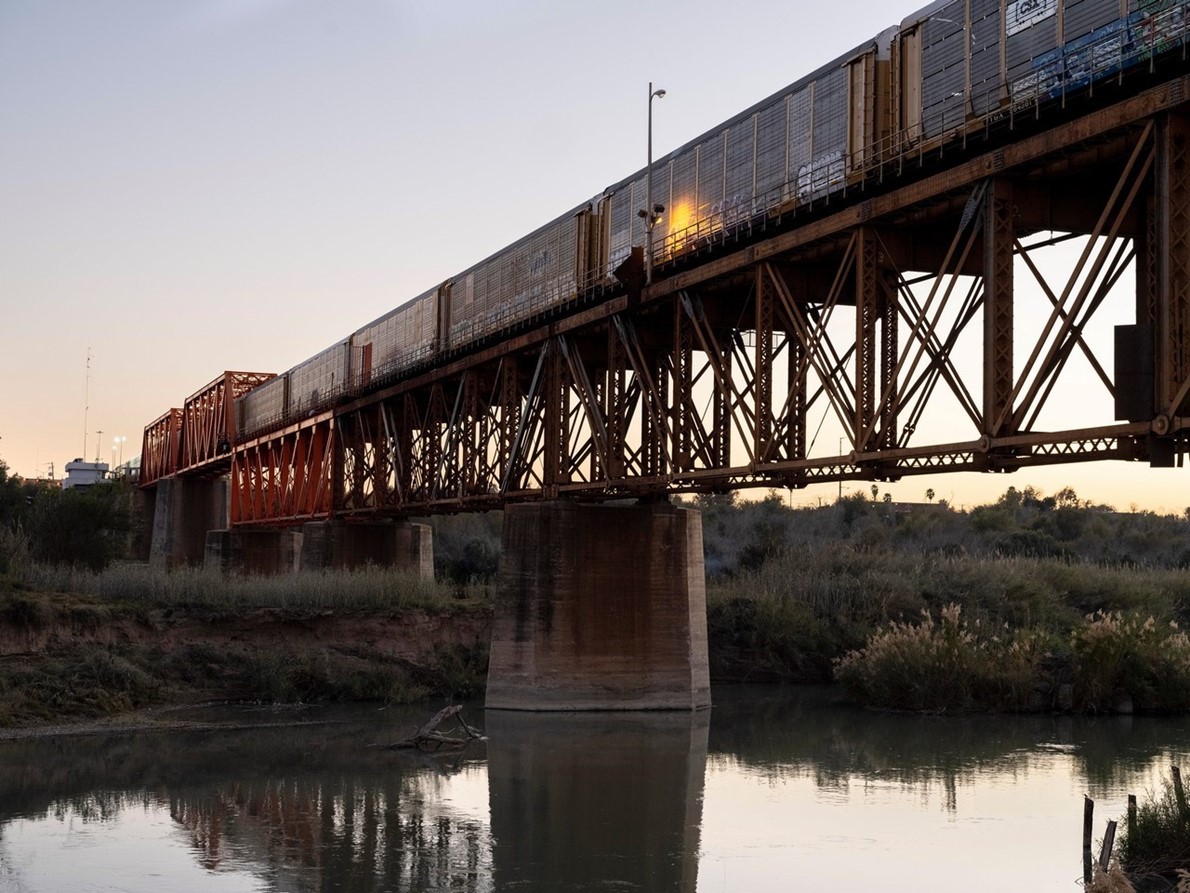LAREDO, United States — The teeming
warehouses carved into the desert surrounding Laredo, Texas attest to an
explosion of trade between the US and Mexico.
اضافة اعلان
On a recent morning, 55-gallon drums full
of chemicals concocted in Ohio awaited trucks that would haul them across the
Rio Grande, for use as raw materials at a paint factory in Mexico’s industrial
city of Monterrey. Destined northbound, brake pads manufactured in
Mexico were
headed to trucking firms as far away as South Dakota.
 Trucks pass
through a toll area before crossing into Mexico on the World Trade Bridge,
which handles only commercial traffic, in Laredo, Texas, on December 28, 2022.
Trucks pass
through a toll area before crossing into Mexico on the World Trade Bridge,
which handles only commercial traffic, in Laredo, Texas, on December 28, 2022.
The more trade expands, the greater the
opportunities for Laredo, a sprawling city of over 250,000 people that has long
been the dominant land port on the meandering border between the
US and Mexico.
Now, it is poised to become an even more vital component of the global economy.
American companies sobered by the supply-chain upheavals of the pandemic and
alarmed by the animosity between the US and China are reducing their dependence
on factories across the Pacific by shifting production to Mexico.
Already, about $800 million worth of
products as diverse as auto parts, clothing, and avocados pass through Laredo
every day. That reality is underscored by the parade of trucks rumbling
through, waiting — often for hours — for their chance to cross a bridge
spanning the Rio Grande, the murky river dividing Texas from
Mexico.
By nearly every indication, more goods are
on the way, presenting customs brokers, freight handlers, and trucking
companies with a monumental opportunity.
“It’s a hectic town. It’s astonishing the amount of movement that the city sees in terms of freight.”
“Everyone’s been growing around here — 10,
20, 30 percent every year,” said Pablo Garza, 30, head of strategic planning at
Akzent Logistics, which owns two warehouses in Laredo and is nearly finished
constructing a third. “It’s a hectic town. It’s astonishing the amount of
movement that the city sees in terms of freight.”
Catching up with a trade explosionDuring an event at City Hall last month,
local officials celebrated a milestone — data revealing that $27 billion worth
of freight moved through Laredo in October, exceeding the flow through the twin
ocean ports of Los Angeles and Long Beach, California, the primary gateway for
American imports.
The Southern California ports grew
exponentially during an era of globalization centered on China. Laredo appears
primed to assume a similar role in the anticipated next phase of globalization,
one centered on regional supply chains, with American companies forging greater
reliance on
Mexico and Central America.
But the exhilaration comes tinged with
anxiety as businesses and city leaders fret that the existing infrastructure —
a pair of commercial bridges spanning the Rio Grande, traffic-choked roads, and
a hive of warehouses — could be overwhelmed by an influx of cargo.
“We’ve got to get ahead of this tsunami
that’s coming,” said Laredo’s then-mayor, Pete Saenz. “We’re behind now.”
A huge build-out is underway. North of the
city, an army of excavators tore at the pale soil, turning ranch land dotted by
cactus into industrial parks, warehouses and trucking yards on both sides of
Interstate 35, the ribbon of pavement
linking Mexico to the midsection of the
US and Canada.
Some 186,000 square meters of warehouse
space is under construction in Laredo, according to Prologis, a real estate
investment firm. That amounts to a 5 percent increase in space.
But with warehouses more than 98 percent
occupied, the new facilities may be quickly filled.
“A lot of companies are no longer willing to chase cheap labor at the cost of getting their goods to customers on time.”
“There’s definitely a space issue in
Laredo,” Garza said. “Warehouses are full. We say no to clients a lot.”
Only the beginning?Goods traded between the US and Mexico in
2021 exceeded $660 billion, an increase of nearly one-fifth from the previous
year, according to US census data. Trade expanded at a similar clip last year,
according to available data.
Adding to the urgency is the widely held
assumption that this is merely the beginning of what could be decades of growth
in trade between the two neighboring countries, as American retailers seek
suppliers in the same hemisphere as their customers.
“A lot of companies are no longer willing
to chase cheap labor at the cost of getting their goods to customers on time,”
said Gene Lindgren, president of the Laredo Economic Development Corp., which
courts investment for projects in the area. “China’s so big that just taking a
tiny little slice and putting it in Mexico is huge for Laredo.”
Four years ago, the US Department of
Transportation projected steep increases in trucks passing through Laredo, with
southbound border crossings alone reaching 9,800 by 2025. Traffic reached that
level by the end of 2021, four years earlier than anticipated.
“All the projections are behind,” said
Glafiro Montemayor, president of Gemco, another Laredo-based freight handler.
He noted that goods crossing the border had more than doubled since 2000
without the addition of major infrastructure.
Already, some American companies importing goods from Asia are bypassing the docks in Southern California and shipping instead to Manzanillo, on Mexico’s Pacific coast.
“Laredo is full of trucks,” he added. “How
are you going to handle it?”
Streamlining logisticsMontemayor is raising funding for a project
presented as the answer to that question: a $360 million bridge crossing the
Rio Grande south of Laredo. The customs process would be handled jointly by
American and Mexican authorities, entailing only one inspection. That would
allow trucks to complete the crossing within 30 minutes.
The Mexican government has already approved
the project, Montemayor said, while the US State Department is nearing the
completion of its own review.
His plan is a linchpin to a logistics hub
that could provide an alternative to excessive reliance on major ports like Los
Angeles, the scene of torturous floating traffic jams during the worst months
of the pandemic.
Nearly two-thirds of the containers
reaching ocean ports on the West Coast of the US are destined for the middle of
the country and the East Coast — regions reached more easily by rail and truck
from Laredo, Montemayor said.
 The
Kansas City Southern railroad bridge, which connects Mexico and the US over the
Rio Grande, in Laredo, Texas.
The
Kansas City Southern railroad bridge, which connects Mexico and the US over the
Rio Grande, in Laredo, Texas.
Already, some American companies importing
goods from Asia are bypassing the docks in Southern California and shipping
instead to Manzanillo, on Mexico’s Pacific coast. From there, they move
containers north to Laredo en route to destinations across North America.
Kansas City Southern, the giant railroad,
picks up containers arriving from Asia at the port of Lázaro Cárdenas, in the
Mexican state of Michoacán, and carries them north. The company recently broke
ground on a $100 million project that will double the capacity of a rail bridge
spanning the Rio Grande.
At the same time, Mexican authorities are
pursuing their own plans to ease the flow of goods across the border.
In Laredo, business interests and local
government officials accuse state and federal authorities of jeopardizing the
opportunities for the region by withholding funds needed to expand the
surrounding highway system.
They complain that the Texas Department of
Transportation bases highway funding on population size — a process that favors
major cities like Dallas and Houston — even though the traffic passing through
Laredo supports jobs at retailers and warehouses across the state and beyond.
Read more Odd and Bizarre
Jordan News



